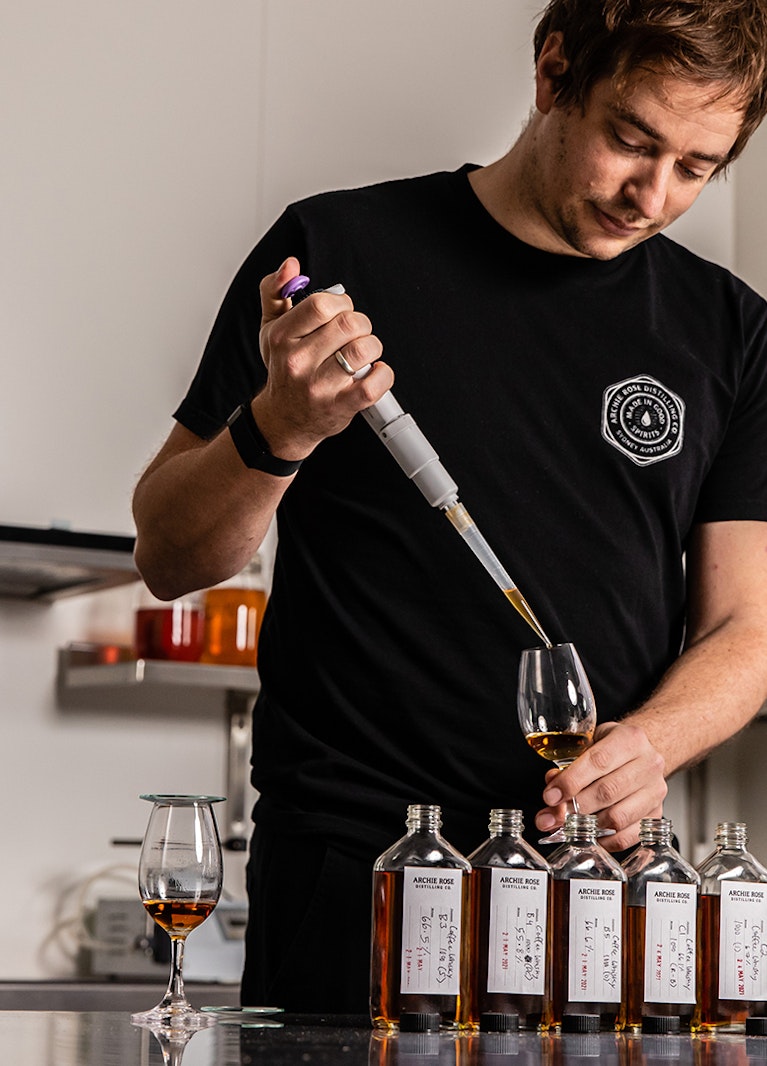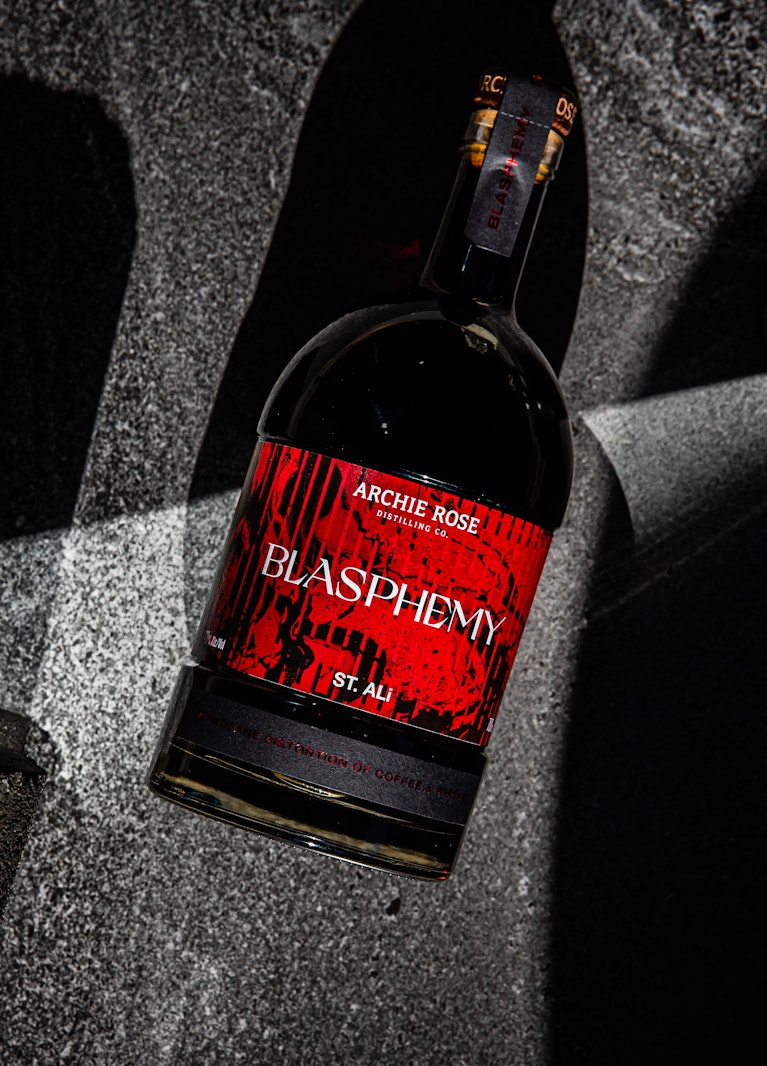BLASPHEMY: ALL YOUR QUESTIONS ANSWERED
Archie Rose x ST. ALi Blasphemy Coffee Whisky is a first for us here at Archie Rose. It’s whisky. And coffee. Together! Blasphemy also brings together our drive to innovate, our love of collaboration, and our mission to produce the finest quality spirits. Yes, we called it Blasphemy (we can be funny too, see!) but in truth, the meeting of these two liquid obsessions makes perfect sense. How, you ask? Who better to answer that question than the man who brought Blasphemy to life: our Senior Spirits Blender David Fisher AKA Fish. Fish took the lead on the production of this limited-edition spirit, so we stole him away from his sensory lab to quiz him on exactly how Blasphemy came to be.

It’s not whisky and it’s not coffee… So, what is Blasphemy?
It’s hard to classify as it doesn’t fit into any existing categories. It sits between whisky and liqueur. In terms of the actual flavour profile, we made sure that Blasphemy wasn’t just the sum of the two parts, but something that stood out on its own. It was a chance for us to push the boundaries of what has been done before in this area. Unless you have used our Single Malt Whisky for your Irish Coffees, then it’s probably unlike anything you’ve tried before.
We employed the same process that we use to make our Single Malt Whisky and Rye Malt Whisky, the only difference is that we replaced some of the water for adjusting the alcohol level with coffee. In terms of the flavour profile, it is more reliant on our Single Malt, but the coffee is not just background noise, it is integrated.
Why use our Single Malt Whisky in this spirit?
Our six malt recipe is all about pushing the boundaries of flavour in whisky. The specialty malts that we use in our Single Malts give us a unique combination of amaretto, espresso and chocolate flavours. We felt that this would pair up really well with the profiles of ST. ALi’s coffee and I might be biased, but I think we were right.
What about the ST. ALi coffee blends used - how did you land on them?
The two blends we selected together with ST. ALi are Wide Awake and Orthodox. We had several discussions with the team over at St ALi, ranging from where the beans were sourced, to preparation methods and roasting profiles. These discussions helped us narrow down which blends and preparation methods we thought would be best suited. We used Wide Awake with a cold drip preparation to lean into the orchard fruit and milk chocolate flavours. For the Orthodox blend, which is slightly lighter, we used a hot steep method to get more classic coffee notes of dark chocolate and dark stewed fruit, without going too heavy on the coffee flavours.
Was the coffee and whisky flavour match easy to achieve or did it require a bit of workshopping?
There was a lot of workshopping that went on. We wanted to avoid using sugar or other sweeteners, which made the flavour match difficult. Essentially the more coffee you add the more dried out and bitter the spirit becomes. To counteract this we took advantage of the different preparation methods of the coffee to accentuate the flavours we wanted without generating too much bitterness. Utilising different preparations allowed us to control the mouthfeel of the final spirit too.

Talk us through the production processes that brought Blasphemy to life…
This product is a great example of true collaboration. We utilised the skill set of ST. ALi to do what they do best and create two amazing coffee products, while our dedicated team of cellar hands picked out and decanted the Single Malt we had earmarked for the process. We then classified the 10,000 litres of Single Malt into 11 different flavour categories to simplify the blending process.
We decided not to use any preservatives in the product, which meant we had to have the coffee shipped up as refrigerated freight and kept at pretty close to zero right up until blending. We then used some clever tricks from our friends in the wine industry to minimise the solids in the coffee. Samples of all the whisky and coffee were then taken into the lab to do our final full-scale blend. Once we were confident that we had created what we had set out to do, we took our lab recipe and had the cellar hands and distillers work their magic and blend the recipe at full scale.
To blend the spirit, we used blending towers that were originally from the Rosebery site. These towers have a capacity of 7,400 litres each and are almost three stories high—not something you can chuck in the back of a van. Instead, they were painstakingly cut into three pieces each, then transported from Rosebery to Banksmeadow, where they were welded back together.
Was that process planned from beginning to end, or did you experiment as you went?
We did a lot of experimentation in our labs here in Banksmeadow at the beginning of the process. We knew there were going to be some challenges creating a spirit that used coffee, a product we don’t usually use, so we made sure we had thought through and planned the process before we began. Though I’d be lying if I said we didn’t have to make some changes along the way to respond to unseen opportunities.
Were there any challenges involved?
We wanted to take a risk and attempt to create a product that stood out on its own, so the biggest challenge was the flavour profile—making sure the product wasn’t overly dominated by the coffee or the Single Malt.
How many versions did you go through to get the final result?
Around 50 different versions. In the initial planning stage, we had around 20 or so iterations to get a starting whisky profile. We then had around the same number of trials getting the whisky and coffee flavour profile correct, and once we had all the products ready for blending I did around 10 blends to get the final product.
What's special about the final product?
There are a couple of things that make this product very special. The way the coffee blends with the heavier notes from the whisky is really interesting—it gives a complex and robust presence on the palate. What I love about it though, is that we were able to get the balance just right so that those base notes don’t dominate, but allow all the lighter, more nuanced notes to shine. That sense of tension makes for a spirit that is full of drama.
How does Blasphemy taste?
The spirit is definitely dry. The oak characteristics from the whisky give the perception of sweetness on the front palate, but on the transition into the mid and back palate, the coffee flavours start to build and give a nice dry finish.
Why would some whisky purists call this Blasphemy?
There is an element of the whisky community that says you should never add anything to whisky. In my mind, the world of whisky and spirits was born through experimentation. At Archie Rose we experiment every day; from making slight adjustments to mashing processes, all the way to figuring out how to make buttered toast and spread into a spirit. I figure the more we experiment, the better our products as a whole become. And if we can make some really interesting, thought-provoking spirits along the way, then all the better for it.